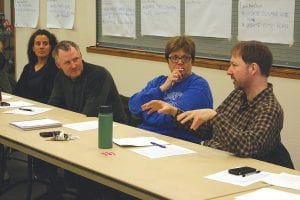Lake Superior Trading Post owner Eric Humphrey explains his views on a GreenStep City Best Practice to a group of 22 community leaders who gathered to discuss the program and brainstorm options. The public is invited to do the same next Monday, April 28, 7:00 p.m. at the Community Center. From left, Ilena Berg, Cook County Soil and Water; David Demmer, Cook County Planning and Zoning; and County Commissioner Sue Hakes listen.

On April 14, 2014, a group of 22 community leaders gathered at the Cook County Community Center to learn about the GreenStep Cities program. The meeting focused on identifying actions already accomplished and possible others to pursue. The group included government representatives from Grand Marais, Cook County, and U.S. Forest Service, Grand Marais businesses and nonprofits, and the Cook County Chamber of Commerce.
Cook County Local Energy Project (CCLEP) board members George Wilkes and Rick Schubert and GreenStep intern Michael Kedrowski from University of Minnesota – Duluth, placed 28 large sheets of paper around the room that listed 28 best practices, the cornerstone of the GreenStep City program. Community leaders offered up existing programs that fulfilled a practice and brainstormed potential actions for practices. Then the group placed stickers on actions they considered most important to pursue.
GreenStep Cities is a voluntary challenge, assistance and recognition program to help Minnesota cities achieve sustainability and quality-of-life goals. This free continuous improvement program is based upon 28 best practices. Each best practice can be implemented by completing one or more actions at a one-, two- or three-star level from a list of four to eight actions.
The general public is invited to an open meeting on Monday, April 28, 7:00 p.m. at the Cook County Community Center. CCLEP and the Grand Marais City Council are looking to present this program to the community and receive feedback about plans that should be pursued in regards to sustainable savings and hear about great things Grand Marais is already doing in planning for a more sustainable 21st century. Organizers encourage the public to come to informally vote and discuss these issues.
For more information about the GreenStep City program and process, visit http://greenstep.pca.state.mn.us/ aboutProgram.cfm. You may also contact George Wilkes at 387-2137, Rick Schubert at 475-2778 or e-mail Michael at kedro021@d.umn.edu with questions.
GreenStep Cities 28 Best Practices
Buildings and Lighting
1. Efficient Existing Public Buildings
2. Efficient Existing Private Buildings
3. New Green Buildings
4. Efficient Outdoor Lighting and Signals
5. Building Reuse
Land Use
6. Comprehensive Plan and Implementation
7. Efficient City Growth
8. Mixed Uses
9. Efficient Highway-Oriented Development
10. Conservation Design
Transportation
11. Complete Green Streets
12. Mobility Options
13. Efficient City Fleets
14. Demand-Side Travel Planning
Environmental Management
15. Purchasing
16. Urban Forests
17. Efficient Stormwater Management
18. Parks and Trails
19. Surface Water Quality
20. Efficient Water and Wastewater Facilities
21. Septic Systems
22. Solid Waste Reduction
23. Local Air Quality
Economic and Community Development
24. Benchmarks & Community Engagement
25. Green Business Development
26. Renewable Energy
27. Local Food
28. Business Synergies
| http://greenstep.pca.state.mn.us/bestPractices.cfm


Loading Comments